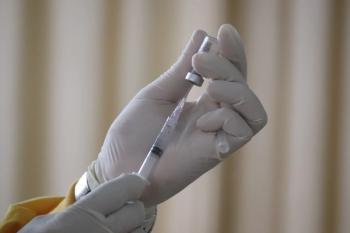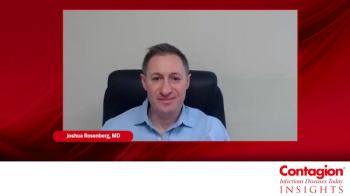
Oral Vancomycin "Tail" Offers No Added Benefit for CDI Prophylaxis
At MAD-ID 2025, Jiye Park, PharmD, presents findings showing once-daily dosing is effective, with no added benefit from extended vancomycin use after antibiotics.
A study presented at MAD-ID 2025 by Jennifer (Jiye) Park, PharmD, evaluated the clinical utility of oral vancomycin as secondary prophylaxis for Clostridioides difficile infection (CDI) and found no statistically significant benefit in extending its use beyond the completion of systemic antibiotics.
The retrospective analysis, conducted at Massachusetts General Hospital between January 1 and December 31, 2022, included 163 adult inpatient encounters. Eligible patients were 18 years or older, had a documented history of CDI, and received systemic antibiotics for at least 24 hours during hospitalization. Patients were excluded if they had no prior CDI, had used prophylactic oral vancomycin within seven days before admission, or were receiving treatment-dose vancomycin.
Park explained, “Our study looked at patients who receive oral vancomycin prophylaxis for secondary C diff prophylaxis, specifically comparing the groups who receive oral vancomycin beyond the end date of their systemic antibiotics—which we term as an ‘oral vancomycin tail’—compared to those who do not receive an extended oral vancomycin duration beyond the last day of systemic antibiotics.”
Out of the 163 cases, 106 patients continued vancomycin after completing systemic antibiotics, while 57 stopped vancomycin on the same day as antibiotic cessation. Recurrent CDI within six months occurred in 14.15% of patients in the continuation group and 14.04% in the non-continuation group (p=.98). CDI-related rehospitalization rates were 11.32% in the continuation group and 5.26% in the non-continuation group (p=.20). Mortality within six months was 16.98% in the continuation group versus 29.82% in the non-continuation group (p=.06).
Park noted, “We found that there was no statistically significant difference in patients who received a tail versus no tail when it came to six-month outcomes of C diff-related recurrence, mortality, and hospitalization.”
The study also assessed the impact of dosing frequency. Among patients who received once-daily prophylaxis, 13.04% experienced recurrent CDI, compared to 14.89% of those who received twice-daily dosing (p=.74). “Also, comparing groups who received once-daily versus twice-daily oral vancomycin prophylaxis, there was also no statistically significant difference in those similar outcomes of six-month C diff recurrence, mortality, and hospitalization,” Park said.
Based on these findings, the researchers implemented changes to clinical workflows at their institution. “I think one thing that we can do from our results is to confidently tailor our oral vancomycin prophylaxis regimens to be once daily as opposed to twice daily,” Park said. “At our institution, we’ve actually already implemented this by removing the twice-daily dosing button option from our electronic health record, just so that providers are guided towards the utilization of once-daily dosing regimens for oral vancomycin prophylaxis.”
Although overall findings showed no statistical difference in outcomes, the data did reveal a lower mortality rate in the group receiving the vancomycin tail. Park emphasized caution in interpreting this: “When it comes to tail versus no tail, we actually observed that there was reduced mortality in the tail group. I think this is difficult to interpret and can really be nuanced and dependent on patient-specific factors, or potentially our patient population at MGH.”
She added, “This requires a little bit more looking into—potentially doing a matched cohort study with patients who have similar risk factors. Overall, it could be that the patients at our hospital were a little bit sicker, so it’s a little bit difficult to interpret those results for tail versus no tail.”
When asked whether certain subgroups might still benefit from extended prophylaxis, Park responded, “Yeah, so I think again, a matched cohort study with patients who have similar risk factors will really be beneficial to tease out who benefits from a tail versus who benefits from receiving no tail.”
Although the study did not include specific subgroup analyses, Park identified populations that could be relevant for future research. “We didn’t do specific subgroup analyses of our patients and their risk factors or specific characteristics, but I think likely looking at their severity and significant history of C diff infection—particularly related to their history of recurrences or if they’ve had a C diff infection in the last 30 days—and also looking at their immunosuppression status, as in smaller scale studies, those have been proven to be some risk factors for recurrent infection.”
Looking ahead, Park highlighted several directions for further investigation. “Yeah, I think again, looking at prospective studies that compare patients—looking specifically at those patient populations who are immunosuppressed or have significant recurrence history—will really be beneficial to see if those patients benefit from receiving a tail versus no tail.”
She also emphasized the need to explore dosing duration. “Other things that I think would be helpful to look at would be the optimal duration of a tail therapy if it is given. The median duration in our patient population was about seven days for the tail therapy, but seeing if we can do shorter regimens of like two to three days—as opposed to seven days—to still have the beneficial outcomes on their risk of C diff recurrence would be helpful.”
Reference
Park J, Ingling G, Petrucelli N, Rock A, Wu T. Evaluation of Post-Antibiotic Oral Vancomycin for Clostridioides difficile Prophylaxis. Abstract 12 OR FRS. MAD-ID Meeting. May 28–31, 2025. Orlando, FL.
Newsletter
Stay ahead of emerging infectious disease threats with expert insights and breaking research. Subscribe now to get updates delivered straight to your inbox.

















































































































































































































































































